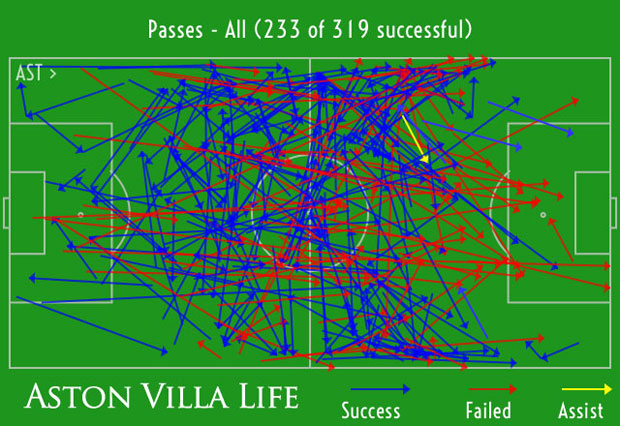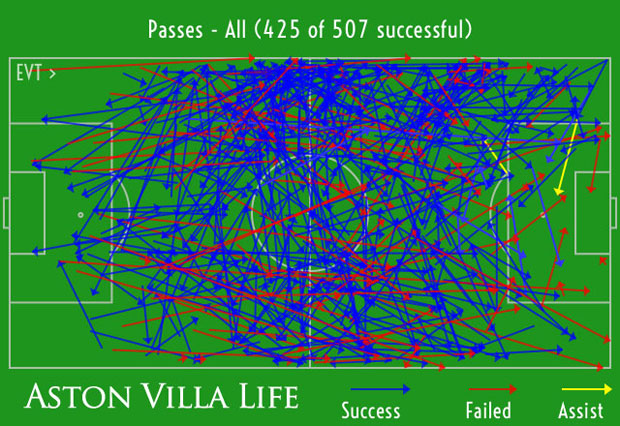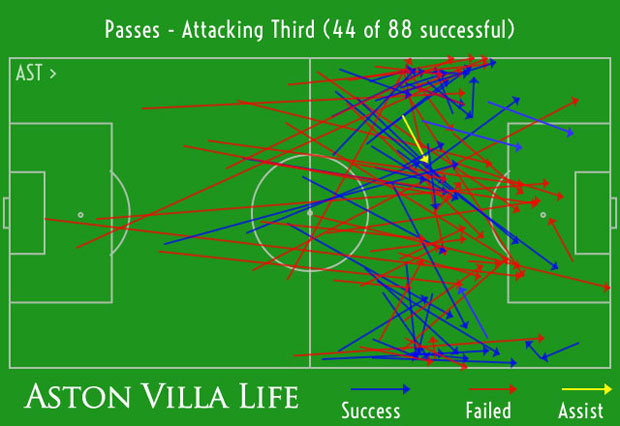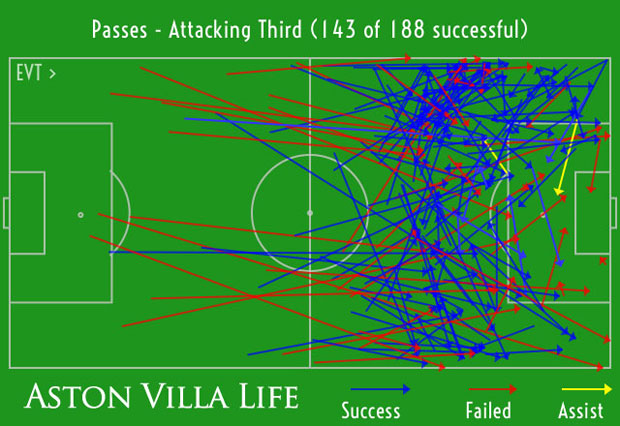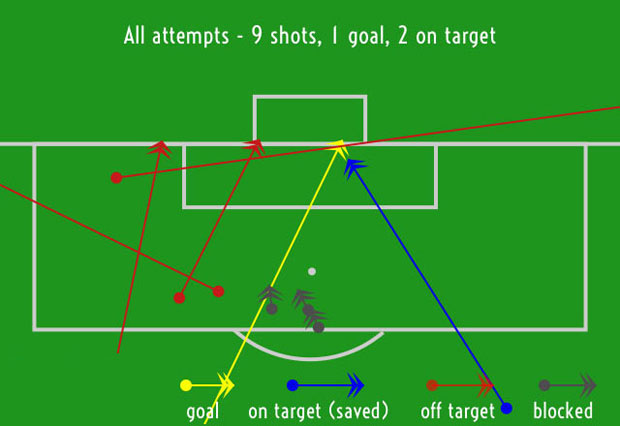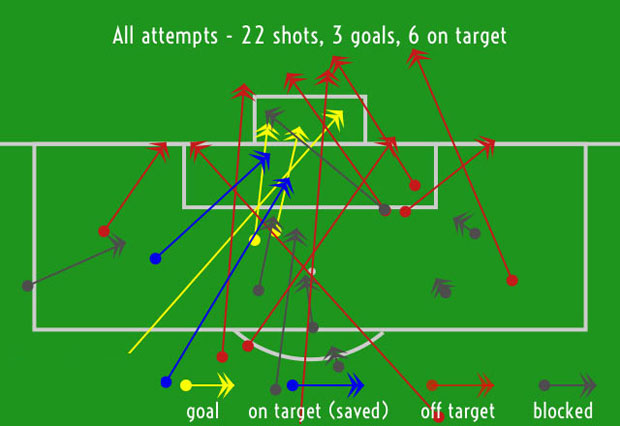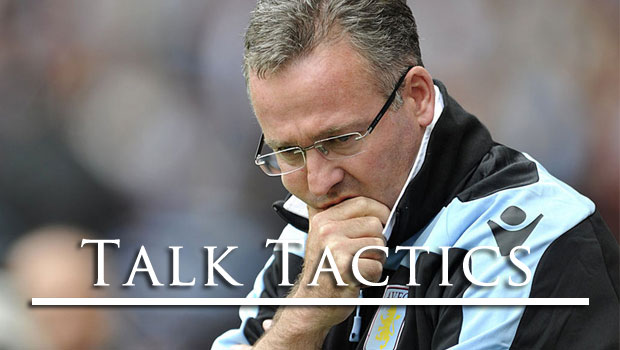

After a day or so to digest the result – warts and all – it’s time to look at why we lost that game. Some of the issues were obvious – players out of position, Barry Bannan in a head to head with a full 9.5 inches taller Marouane Fellaini, and a lack of effort.
It isn’t sufficient for our manager or owner to be angry with the result though, and Paul Lambert will be scrutinising the information he has available to work out the next stages of how Aston Villa can pick themselves up. We no longer have much time to get the next steps sorted, so it’s time to do something about it.
I’ll start by looking at the general passing figures. Below are Villa’s – and they show a few things when referenced which I will pick up on after the image.
When we compare the amount of passes that Villa managed on Saturday, it is a fairly significantly smaller number than we managed against West Ham. As I said in my tactical analysis of the West Ham game, not all teams will sit back as they did in order to win games. Sometimes, such as on Saturday, teams will just be better player for player, and will come to win.
In those instances, they will see more territory whether they pass the ball around or not. Whilst Everton’s territory domination was far from comprehensive, their ability to move the ball forward quickly – and not just via long balls – meant that our midfield were on the back foot. Considering the team were playing at home, you have to wonder what caused such a defensive attitude.
Last season, much of the defensive nature of the team was shouldered by Alex McLeish. In a new season where nothing about Paul Lambert’s past screams “defensive play with hoofed balls”, the same repetitive issues become increasingly obvious in their reasoning – many players simply are not good enough. If you look at the passes Villa made in the above graphic, most of the failed passes (those in red) are long balls, borne out of panic. I’ll go into further detail when I look at Villa’s attacking passes.
Villa were closed down because Everton were not going to sit back like West Ham did. Below are Everton’s overall passing statistics, illustrating that our team were dominated in passing terms as well as in terms of scoreline.
Everton may have only put four less passes astray compared to Villa’s total, but they managed a full 188 passes more than Villa overall.
Moving on to attacking passes, it’s important to look at how these worked out for Villa. First up is the graphic that shows the passes Villa made which I will go into detail about following the image:
Villa has a mere 50% completion rate for attacking third passes and, as the image above illustrates, many of these failed passes were long balls. Without taking a whole book worth of writing to go through every pass individually, it should be evident to fans that the long balls pumped forward were two things – unsuccessful (for the most part), and panicked. We will all agree that whilst McLeish may have been tarred with a long ball ethos, long balls made by players under Lambert were coming from player choice, not managerial direction.
Often players were resorting to having to kick the ball long because Everton were closing Villa down all across the pitch. The abilities of some of the players that looked adequate in pre-season were shown in a different light against a team that will be chasing Europe this season. Put simply, there are players who are not good enough.
If fans want to think of Villa as a top team, regardless of whether we are or not, it should be a universal point of agreement that a player in a top team can handle pressure and shouldn’t, as many of our team do, capitulate under it. If ever there was an argument for experience in the team, this game underlined it.
Of the team as it stands, only Karim El-Ahmadi displayed calm under pressure in the middle of the midfield. In defence, Ron Vlaar was solid. Lambert’s purchases seem evidently up to scratch, it’s just a shame he hasn’t managed that many. We can only hope he manages more this week. As fans, we must be patient for the next week and see what happens – winding ourselves up with speculation about what may or may not happen is only going to raise the collective blood pressure of us all.
Moving on from Villa’s attacking third passing, it is important to look at Everton’s to see how our defence was pushed. Below is a graphic of Everton’s attacking third passes:
On initial analysis of the passing, it is easy to see graphically that Everton were managing to push and exploit the flanks very easily. What might surprise some fans is that the right hand side of the defence (Everton’s left of attack and the top of the graphic) was exploited all the way back to the goal line. Multiple times the ball was cut back from a player and both assists came from that side.
Again, as with Villa, long balls often didn’t work too well with the majority of the longest passes failing to complete. However, Everton simply managed to pass the ball more, leaving Villa’s midfield operating deep because of extended pressure by Steven Pienaar and the impressive Fellaini, supported on Everton’s left flank by England international Leighton Baines.
The final section to look at is the goalscoring opportunities presented by both teams. First, I’ll look at Villa’s attempts:
As we can see by Villa’s sparse number of chances, one was El-Ahmadi’s goal, three shots were blocked promptly within a few yards, two went massively wide, one wide by a smaller margin, Andreas Weimann’s shot against the post, and one further on target target shot.
The reality is that even if Villa had scored with every on target shot that they had, the team would still have lost 3-2, though there may well be a strong argument that one of Everton’s goals could have been avoided if Shay Given had been on form. It wouldn’t surprise me if he loses his place to Brad Guzan because of that flapping error.
Everton had 22 shots, and a full six on target. All I will add to Everton’s visual representation of chance is this – it’s clearly evident that Villa’s midfield and attack need to push harder if they want to achieve a similar number of attempts.
So, to conclude, we can see some key issues arising. Firstly, the midfield is either sitting too deep or is being pressed back because El-Ahmadi alone can’t stem the tide of constant pressure from multiple players – this in turn causes issues with striker isolation.
Secondly, the defence is clearly a work in progress. Whether it will stay as is will ultimately be at the discretion of the manager, though it appeared like Nathan Baker played better in the middle than Clark did – we may well see Lichaj on the left with Baker inside until Richard Dunne returns at least.
It’s been said many times in recent weeks, but the team is not up to scratch as it currently stands. We can only hope that Lambert’s pursuit of players are going on in quiet as we slowly approach the transfer window. In the meantime, don’t be surprised if we see yet another change of style against Tranmere on Tuesday as Lambert’s nascent team do their best to coalesce.
Podcast: Play in new window | Download
